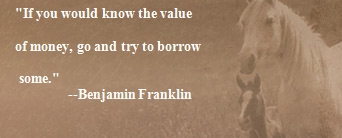
Saddles,
Saddles Page
Please allow 2-3 minutes for photos to load.
Longer for video.
~ Roping ~
~ Cutting ~
~ Barrel ~
~ Endurance ~
~ Trail ~
~ Ranch ~
Order Form for Joni Lund Equine Services Trading Post >>
Discount for North Dakota customers.
Saddle Facts: A lite working saddle will be 40 lbs, a heavy working saddle will be 60-65 lbs.
Next place the flat of your palm against the side of the horse, under the saddle, and see if you can slide your fingertips forward and back, to make sure the saddle is bearing weight along its length.
(For fat and broad horses it is ok to have a bit of clearance in the center of the bars (between front and rear) to allow the back to rise comfortably into contact with tree when at work. You can get the flat of your hand under the bars, then the horse will have room to move up into the bars when in movement. (I mention this to say it is not too much room.)
For a slim or skinny horse the room under the center of the bars needs to be much less.
A saddle that fits well at rest will not make your horse uncomfortable at rest. But when at work can and will sore the back by not allowing the back to rise up fully and then bearing the weight in collection. (Room or rock in the bars needs to be less to allow the back to rise up into full collection at which time it contacts the tree.)
Next stand back and eyeball the saddle. Is it level? (Imagine where the tree is and sight to see if it is level.
A down hill saddle will sore the withers. This is especially true when the gullet is too wide for the horse.
A saddle that is too narrow will slide back and will not function correctly.
Palpate your horse's back after unsaddling. If the back drops, the horse is sore. If he twitches you are only annoying him.
Dry spots are an indication of more pressure in that area than in a wet area. A dry spot is only a problem pressure area if when palpated the horse is sore.
DISCLAIMER: The sport of riding/driving/using a horse/mule/donkey/steer/dog/ox is done with some inherent risks.
Due to the nature of the type of products we sell at Joni Lund Equine Services we will not be help responsible for the use or misuse of the products we sell.
Upon receipt of the item you purchased from us, it is your responsibility to thoroughly inspect each item for safety and soundness before use.
(It is your responsibility to check all your tack and saddle equipment BEFORE EACH USE for wear, splits, cracks, tares, over driness, over oiliness, which would make your equipment unsafe to use.)
It is your responsibility to have it repaired or replaced before someone or you use it.
Do not make holes with a nail! This makes for tares and splits. Check rivets (for wearing through the holes, buckle attachments( thin, brittle, cracked, or broken), strings, straps, cinches, stirrups, and check stirrups up over the bars the moving them lower to inspect. Thoroughly check rigging and rigging attachments.
Don't use if thin, torn, or splits/cracks have started.
IT IS YOUR RESPONSIBLITY TO KEEP ALL YOUR EQUIPMENT INSPECTED AND MAINTAINED IN GOOD WORKING ORDER. This includes keeping manure/mud/mold off the leather. Or cleaning, drying & reconditioning after exposeure. Manure will dry and break down the leather fibers. Mold eats it. Mud is an abrasive material which breaks down the leather.
Any NEWLY PURCHASED defective ITEMS SOLD BY US will be replaced by a like item upon the return to the warehouse or a full refund (not including shipping) may be requested at the time of sale by the original customer.
This warranty does not apply to any defects caused by negligence, misuse, alteration, abuse or accidents.
Gaited and non-gaited horse saddles and assocessories.
Training ~ Breeding ~ Sales: Horses & Mules
Joni Lund - Equine Services & Trading Post
1295 1st St S
Carrington, ND 58421
Phone 701- 652-1986
Orders are filled and shipped after payment is recieved, USA approx 2 weeks.
International orders: add 10 days more for shipping. Saddles approx 4 weeks.
Sales of Retail Merchandise
&
Training ~ Breeding ~ Sales: Horses & Mules
Joni Lund - Trading Post
1295 1st St S
Carrington, ND 58421
Call: Phone 701- 652-1986 for more immediate service.
for more immediate service.
 | ||||||